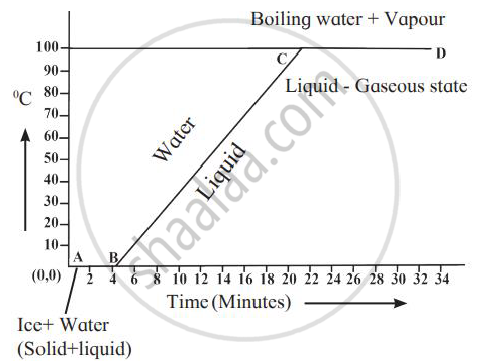Advertisements
Advertisements
प्रश्न
A thermally insulated pot has 150 g ice at temperature 0°C. How much steam of 100°C has to be mixed to it, so that water of temperature 50°C will be obtained? (Given : latent heat of melting of ice = 80 cal/g, latent heat of vaporization of water = 540 cal/g, specific heat of water = 1 cal/g °C)
उत्तर
Amount of heat required in converting 150 g ice to 0°C to water at 0°C = \[150 \times 80 = 12000 \text { cal }\]
Amount of heat energy required in heating 150 g water at 0°C to 150 g water at 50°C = \[150 \times 1 \times 50 = 7500 \text { cal }\]
Total heat energy required to convert 150 g ice at 0°C to water at 50°C = 19500 cal
Let m g be the amount of steam be mixed with water to bring the final temperature of system at 50°C.
The amount of heat released in converting m g of steam at 100°C to water at 100°C = \[m \times 540 = 540m\]
The amount of heat released in converting m g of water at 100°C to water at 50°C = \[m \times \times 1 \times 50 = 50m\]
Total heat energy released to convert m g steam at 100°C to water at 50°C = 590m cal
Using the principle of calorimetry, we have
590m = 19500
\[m = \frac{19500}{590} = 33 g\]
APPEARS IN
संबंधित प्रश्न
State any two measures to minimize the impact of global warming.
What is the energy absorbed during the phase change called?
What do you understand by the term latent heat?
1 g ice of 0℃ melts to form 1 g water at 0℃. State whether the latent heat is absorbed or given out by ice.
- Which requires more heat: 1 g ice at 0℃ or 1 g water at 0℃ to raise its temperature to 10℃?
- Explain your answer in part (a).
Explain the following:
The heat supplied to a substance during it change of state, does not cause any rise in its temperature.
A refrigerator converts 100g of water at 20℃ to ice at – 10℃ in 73.5 min. Calculate the average rate of heat extraction in watt. The specific heat capacity of water is 4.2 J kg-1 K-1, specific latent heat of ice is 336 J g-1 and the specific heat capacity of ice is 2.1 J kg-1 K-1.
Answer the following:
Explain the role of latent heat in the change of state of a substance.
Liquid ammonia is used in ice factory for making ice from water. If water at 20°C is to be converted into 2 kg ice at 0°C, how many grams of ammonia are to be evaporated? (Given: The latent heat of vaporization of ammonia = 341 cal/g)
Explain the following temperature vs time graph.

What do you mean by the statement?
'The specific latent heat capacity of fusion of ice is 336 J per g'?
Define the following terms:
(i) Specific latent heat,
(ii) Specific latent heat of fusion.
When 1 g of ice at 0 °C melts to form 1 g of water at 0 °C then, is the latent heat absorbed by the ice or given out by it?
The specific latent heat of vaporisation of steam is 2260 J/g. Comment on this.
Explain, why no tracks are left on the ice during ice skating?
Why does evaporation causes cooling and why is water used in hot water bottles?
Find the odd one out and give its explanation.
Write the name.
Products obtained when sugar is heated.
The latent heat of vaporisation is a term referred for the conversion of gas into liquid.
Write scientific reason.
Even if boiling water is constantly heated, its temperature does not rise.
